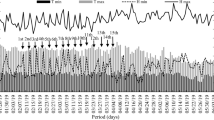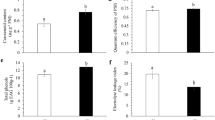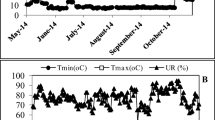Abstract
This study is aimed at assessing whether silicon (Si) can mitigate the effects caused by water stress in pre-sprouted seedlings (PSS) in sugarcane after their transplanting in the soil and what is the best form in the application if via nutrient solution or leaf spraying. The treatments were arranged in a 3 × 3 factorial scheme with silicon supply via nutrient solution (2 mmol L−1), Si via leaf application (3.4 mmol L−1), and without Si (control) and three levels of soil water retention capacity (70%, 50%, and 30%), for 30 days. In the absence of Si, the water deficit was damaging to the physiological, growth, and dry matter production variables of plants, in a 30% level of soil water retention capacity. Silicon supply via nutrient solution was more efficient when compared with Si via leaf spraying in the formation of pre-sprouted sugarcane seedlings in the first 30 days after transplanting, since it increased the quantum efficiency of photosystem II, chlorophyll content, leaf water potential, and water content, decreased cell electrolyte leakage and free proline content, and allowed a higher growth and biomass production. In conclusion, the supply of Si via nutrient solution in pre-sprouted sugarcane seedlings can be considered a feasible alternative to alleviate water deficit damage imposed after transplanting, in a 30% level of soil water retention capacity.







Similar content being viewed by others
References
Amin M, Ahmad R, Basra SMA, Murtaza G (2014) Silicon induced improvement in morpho physiological traits of maize (Zea mays L.) under water deficit. Pak J Agric Sci 51:187–196
Barreto RF, Schiavon Júnior AA, Maggio MA, Prado RM (2017) Silicon alleviates ammonium toxicity in cauliflower and in broccoli. Sci Hortic 225:743–750. https://doi.org/10.1016/j.scienta.2017.08.014
Barrs H, Weatherley P (1962) A re-examination of the relative turgidity technique for estimating water deficits in leaves. Aust J Biol Sci 15:413–428. https://doi.org/10.1071/BI9620413
Bates LS, Waldren RP, Teare ID (1973) Rapid determination of free proline for water-stress studies. Plant Soil 39:205–207. https://doi.org/10.1007/BF00018060
Bokhtiar SM, Huang HR, Li YR, Dalvi VA (2012) Effects of silicon on yield contributing parameters and its accumulation in abaxial epidermis of sugarcane leaf blades using energy dispersive X-ray analysis. J Plant Nutr 35:1255–1275. https://doi.org/10.1080/01904167.2012.676379
Camargo MS, Bezerra BKL, Vitti AC, Silva MA, Oliveira A (2017) Silicon fertilization reduces the deleterious effects of water deficit in sugarcane. J Soil Sci Plant Nutr 17:99–111. https://doi.org/10.4067/s0718-95162017005000008
Camargo MS, Bezerra BKL, Holanda LA, Oliveira AL, Vitti AC, Silva MA (2019) Silicon fertilization improves physiological responses in sugarcane cultivars grown under water deficit. J Soil Sci Plant Nutr 19:81–91. https://doi.org/10.1007/s42729-019-0012-1
Cavalcante VS, Prado RM, Vasconcelos RL, Campos CNS (2016) Iron concentrations in sugar cane (Saccharum officinarum L.) cultivated in nutrient solution. Agrociencia 50:867–875
Detmann KC, Araújo WL, Martins SCV, Sanglard LMVP, Reis J V., Detmann E, Rodrigues FÁ, Nunes-Nesi A, Fernie AR, DaMatta FM (2012) Silicon nutrition increases grain yield, which, in turn, exerts a feed-forward stimulation of photosynthetic rates via enhanced mesophyll conductance and alters primary metabolism in rice. New Phytol 196:752–762
Dionisio-Sese ML, Tobita S (1998) Antioxidant responses of rice seedlings to salinity stress. Plant Sci 135:1–9. https://doi.org/10.1016/S0168-9452(98)00025-9
Embrapa (1997) Manual de métodos de análise de solo. 2a. Rio de Janeiro
Etesami H, Jeong BR (2018) Silicon (Si): review and future prospects on the action mechanisms in alleviating biotic and abiotic stresses in plants. Ecotoxicol Environ Saf 147:881–896. https://doi.org/10.1016/j.ecoenv.2017.09.063
Gong HJ, Chen KM, Chen GC, Wang SM, Zhang CL (2003) Effects of silicon on growth of wheat under drought. J Plant Nutr 26:1055–1063
Gong H, Zhu X, Chen K, Wang S, Zhang C (2005) Silicon alleviates oxidative damage of wheat plants in pots under drought. Plant Sci 169:313–321
Havaux M (2014) Carotenoid oxidation products as stress signals in plants. Plant J 79:597–606
Hoagland DC, Arnon DI (1950) The water culture method for growing plant without soil. The water culture method for growing plant without soil. Berkeley
Jain R, Chandra A, Venugopalan VK, Solomon S (2015) Physiological changes and expression of SOD and P5CS genes in response to water deficit in sugarcane. Sugar Tech 17:276–282. https://doi.org/10.1007/s12355-014-0317-2
Kaya C, Tuna L, Higgs D (2006) Effect of silicon on plant growth and mineral nutrition of maize grown under water-stress conditions. J Plant Nutr 29:1469–1480
Korndörfer GH, Pereira HS, Nolla A (2004) Análise de silício no solo, planta e fertilizante. Uberlândia, UFU
Kraska JE, Breitenbeck GA (2010) Simple, robust method for quantifying silicon in plant tissue. Commun Soil Sci Plant Anal 41:2075–2085
Landell MGA, Campana MP, Figueiredo P, Xavier MA, Anjos IA, Dinardo-Miranda LL, Scarpari MS, Garcia JC, Bidóia MAP, Silva DN, Mendonça JR, Kanthack RAD, Campos MF, Brancalião SR, Petri RH, Miguel PEM (2012) Sistema de multiplicação de cana‑de‑açúcar com uso de mudas pré‑brotadas (MPB), oriundas de gemas individualizadas. Campinas
Liang Y, Nikolic M, Bélanger R, Gong H, Song A (2015) Silicon in agriculture. Silicon in agriculture. Springer Netherlands, Dordrecht. https://doi.org/10.1007/978-94-017-9978-2
Lichtenthaler HK (1987) Chlorophylls and carotenoids: pigments of photosynthetic biomembranes. Methods Enzymol 148:350–382
Lichtenthaler HK, Buschmann C, Knapp M (2005) How to correctly determine the different chlorophyll fluorescence parameters and the chlorophyll fluorescence decrease ratio RFd of leaves with the PAM fluorometer. Photosynthetica 43:379–393
Liu P, Yin L, Deng X, Wang S, Tanaka K, Zhang S (2014) Aquaporin-mediated increase in root hydraulic conductance is involved in silicon-induced improved root water uptake under osmotic stress in Sorghum bicolor L. J Exp Bot 65:4747–4756
Ma JF, Yamaji N, Mitani-Ueno N (2011) Transport of silicon from roots to panicles in plants. Proc Japan Acad Ser B 87:377–385
Marcos FCC, Silveira NM, Mokochinski JB, Sawaya ACHF, Marchiori PER, Machado EC, Souza GM, Landell MGA, Ribeiro RV (2018) Drought tolerance of sugarcane is improved by previous exposure to water deficit. J Plant Physiol 223:9–18. https://doi.org/10.1016/j.jplph.2018.02.001
Martins APC, Albrecht LP, Castaldo J, Carneiro R, Zucareli V (2015) Novas tecnologias no plantio de cana-de-açúcar (Saccharum spp). J Agron Sci 4:301–317
Mitani N, Ma JF (2005) Uptake system of silicon in different plant species. J Exp Bot 56:1255–1261
Mitani N, Yamaji N, Ma JF (2009) Identification of maize silicon influx transporters. Plant Cell Physiol 50:5–12
Oliveira RLL, Prado RM, Felisberto G, Checchio MV, Gratão PL (2019a) Silicon mitigates manganese deficiency stress by regulating the physiology and activity of antioxidant enzymes in sorghum plants. J Soil Sci Plant Nutr 19:1–11. https://doi.org/10.1007/s42729-019-00051-w
Oliveira RLL, Prado RM, Felisberto G, Cruz FJR (2019b) Different sources of silicon by foliar spraying on the growth and gas exchange in sorghum. J Soil Sci Plant Nutr 19:948–953. https://doi.org/10.1007/s42729-019-00092-1
Pei ZF, Ming DF, Liu D, Wan GL, Geng XX, Gong HJ, Zhou WJ (2010) Silicon improves the tolerance to water-deficit stress induced by polyethylene glycol in wheat (Triticum aestivum L.) seedlings. J Plant Growth Regul 29:106–115
Raij BV, Andrade JC, Cantarella HQJ (2001) Análise química para avaliação da fertilidade de solos tropicais. IAC, Campinas
Santos HG, Jacomine PKT, Anjos LHC, Oliveira VA, Lumbreras JF, Coelho MR, Almeida JA, Araújo Filho JC, Oliveira JB, Cunha TJF (2018) Brazilian Soil Classification System, 2a. Embrapa Soils, Brasília
Silva PP, Soares L, Costa JG, Viana LS, Andrade JCF, Gonçalves ER, Santos JM, Barbosa GVS, Nascimento VX, Todaro AR, Riffel A, Grossi-de-As MF, Barbosa MHP, Sant’Ana AEG, Ramalho Neto CE (2012) Path analysis for selection of drought tolerant sugarcane genotypes through physiological components. Ind Crop Prod 37:11–19. https://doi.org/10.1016/j.indcrop.2011.11.015
Turner NC (1981) Techniques and experimental approaches for the measurement of plant water status. Plant Soil 58:339–366. https://doi.org/10.1007/BF02180062
Vandeleur RK, Mayo G, Shelden MC, Gilliham M, Kaiser BN, Tyerman SD (2009) The role of plasma membrane intrinsic protein aquaporins in water transport through roots: diurnal and drought stress responses reveal different strategies between isohydric and anisohydric cultivars of grapevine. Plant Physiol 149:445–460
Acknowledgments
The support of the São Paulo State University (UNESP) is recognized with gratitude.
Funding
This study was funded by Coordenadoria de Aperfeiçoamento de Pessoal de Nível Superior (CAPES), Brazil, Code 001.
Author information
Authors and Affiliations
Corresponding author
Ethics declarations
Conflict of Interest
The authors declare that they have no conflict of interest.
Additional information
Publisher’s note
Springer Nature remains neutral with regard to jurisdictional claims in published maps and institutional affiliations.
Highlights
- Silicon application and soil available water level interaction were evaluated.
- The severe and moderate water deficit decreased by 47 and 21% of plant weight.
- Silicon showed beneficial for sugarcane in water deficit conditions.
- Silicon supplied via nutrient solution mitigate the damages caused by water deficit.
Rights and permissions
About this article
Cite this article
Teixeira, G.C.M., de Mello Prado, R., Rocha, A.M.S. et al. Silicon in Pre-sprouted Sugarcane Seedlings Mitigates the Effects of Water Deficit After Transplanting. J Soil Sci Plant Nutr 20, 849–859 (2020). https://doi.org/10.1007/s42729-019-00170-4
Received:
Accepted:
Published:
Issue Date:
DOI: https://doi.org/10.1007/s42729-019-00170-4




